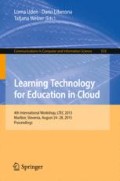Abstract
The incorporation of digital technologies (both multiple purpose and mathematics action technologies) in mathematical learning environments can foster and extend discussions among learners and teachers even beyond class time. That is, learners not only keep reflecting on mathematical ideas or problems; but also they can review or consult related online resources. Similarly, the use of dynamic geometry systems provides affordances to construct dynamic models of tasks where learners can analyse how objects move within the configuration and formulate mathematical relations. In this report, we discuss three exemplars to characterize ways in which the use of technology extends mathematical reasoning in problem solving approaches. This information becomes important for teachers to value and frame the incorporation of technology in learning environments. At the end, some limitations of this approach are discussed.
Access this chapter
Tax calculation will be finalised at checkout
Purchases are for personal use only
References
Walling, D.R.: Designing learning for tablet classroom. Innovation in instruction. Springer, New York (2014)
Alagicc, G., Alagic, M.: Collaborative mathematics learning in online environments. In: Martinovic, D., Freiman, V., Karadac, Z. (eds.) Visual mathematics and cyberlearning, pp. 23–48. Springer, New York (2013)
Barbeau, E.: Introduction. In: Barbeau, E.J., Taylor, P.J. (eds.) Challenging mathematics in and beyond the classroom: the 16th ICMI Study. Springer, New York (2009)
Roschelle, J., Courey, S., Patton, C., Murray, E.: Dynabooks: supporting teachers to engage all learners in key literacies. In: Mouza, C., Lavigne, N. (eds.) Emerging Technologies for the Classroom, Explorations in the Learning Sciences, Instructional Systems and Performance Technologies, pp. 31–46. Springer, New York (2013)
Mason, J., Johnston-Wilder, S.: Designing and Using Mathematical Tasks. Tarquin Publications, St. Albans (2006)
Artigue, M., Mariotti, M.A.: Networking theoretical frames: the ReMath enterprise. Educ. Stud. Math. 85(3), 329–355 (2014)
Santos-Trigo, M.: Problem solving in mathematics education. In: Lerman, S. (ed.) Encyclopedia of Mathematics Education, pp. 496–501. Springer, New York (2014)
Schoenfeld, A.H.: How We Think: A Theory of Goal-Oriented Decision Making and Its Educational Applications. Routledge, New York (2010)
Güçler, B., Hegedus, S., Robidoux, R., Jackiw, N.: Investigating the mathematical discourse of young learners involved in multi-modal mathematical investigation: the case of haptic technologies. In: Martinovic, D., Freiman, V., Karadac, Z. (eds.) Visual Mathematics and Cyberlearning, pp. 97–118. Springer, NY (2014)
Steen, L.A. (ed.): On the Shoulders of Giants: New Approaches to Numeracy. National Academies Press, Washington, DC (1990)
Devlin, K.: Mathematics the science of patterns. Scientific American Library, New York (1994)
Cuoco, A.A.: Mathematics as a way of thinking about things. In: Mathematical Science Education Board, National Research Council (ed.) High school mathematics at work, pp. 102–106. National Academic Press, Washington, DC (1998)
Schoenfeld, A.H.: Mathematical Problem Solving. Academic Press, New York (1985)
Acknowledgements
The authors would like to acknowledge the support received from projects Conacyt-168543 and Plan Nacional I+D+I del MCIN, Reference EDU2011-20328 during the preparation of this article.
Author information
Authors and Affiliations
Corresponding author
Editor information
Editors and Affiliations
Rights and permissions
Copyright information
© 2015 Springer International Publishing Switzerland
About this paper
Cite this paper
Santos-Trigo, M., Reyes-Martínez, I., Aguilar-Magallón, D. (2015). The Use of Digital Technology in Extending Mathematical Problem Solving Reasoning. In: Uden, L., Liberona, D., Welzer, T. (eds) Learning Technology for Education in Cloud. LTEC 2015. Communications in Computer and Information Science, vol 533. Springer, Cham. https://doi.org/10.1007/978-3-319-22629-3_24
Download citation
DOI: https://doi.org/10.1007/978-3-319-22629-3_24
Published:
Publisher Name: Springer, Cham
Print ISBN: 978-3-319-22628-6
Online ISBN: 978-3-319-22629-3
eBook Packages: Computer ScienceComputer Science (R0)

